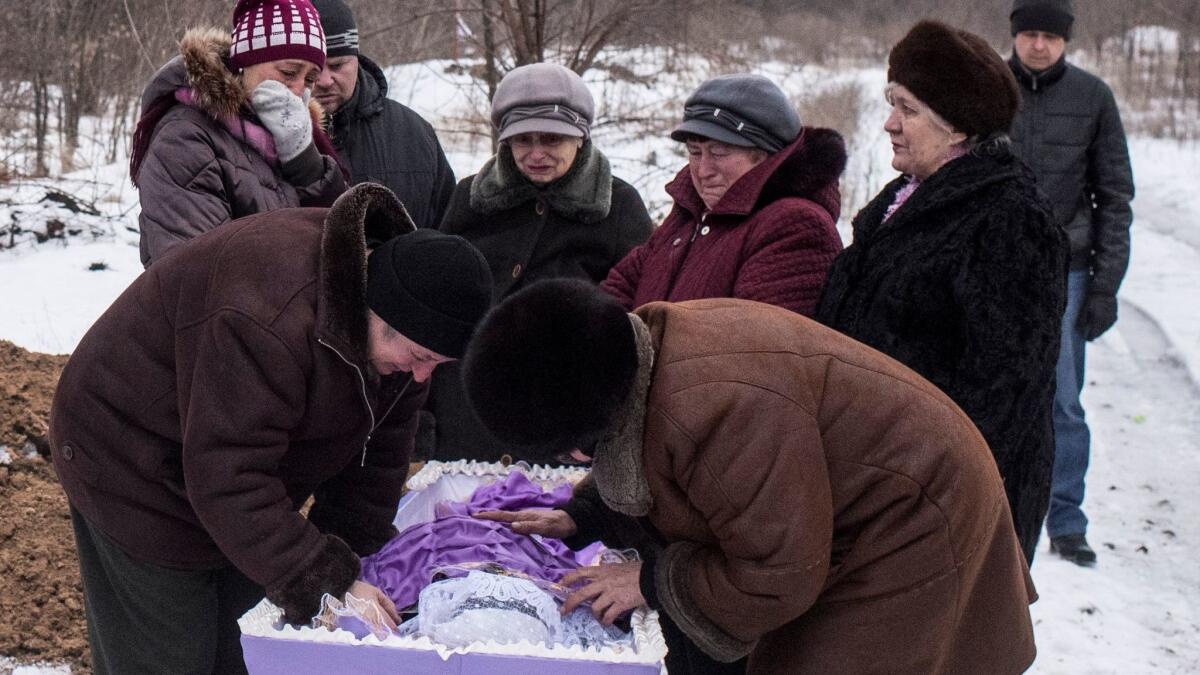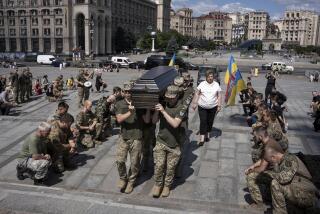Residents in eastern Ukraine face worst fighting in years in war with Russian-backed separatists

- Share via
Mariupol, Ukraine — The news reached Mariupol Mayor Vadim Boychenko via a morning phone call from an assistant: A rocket attack damaged 11 houses on the outskirts of the Ukrainian city.
There were no casualties, but a major concern had become a reality: The escalation of fighting elsewhere in the nation in recent weeks had reached the industrial city, a key component in southeast Ukraine’s struggling economy.
“We’ve gotten used to a peaceful life,” Boychenko said during a recent interview at his office. “I really don’t want to return to the problems we had started to forget.”
Ukraine’s nearly three-year battle against Kremlin-backed separatists in the east erupted into the worst fighting in two years in late January. Exactly why the fighting intensified recently remains unclear, though such encounters have occurred with some frequency during unrest that included Russia’s annexation of Crimea in March 2014.
The small city of Avdiivka, 90 miles north of Mariupol, became the epicenter of the recent violence. The fighting quickly spread along a 300-mile line separating the Ukrainian government-controlled lands and those claimed by separatists in the Donetsk and Luhansk regions.
Mariupol had seen only sporadic fighting over the last two years, primarily in the region’s eastern villages. But as news trickled in about the bombardment of Avdiivka, Mariupol began again hearing the deep rumble of explosions and heavy artillery fire less than 10 miles away.
The fighting halted vital shipments from Avdiivka’s coal processing plant to Mariupol’s massive iron and steel works plants, jeopardizing production at one of the region’s biggest employers.
Many local residents said they feared the renewed violence could quash the growing sense of confidence in Mariupol after nearly two years of relative stability.
One concern in the region is that President Trump and Russian President Vladimir Putin could strike a deal that would lift U.S. sanctions on Russia or force Ukraine to make painful compromises with Moscow. Ukrainian President Petro Poroshenko has urged Western leaders to keep sanctions in place.
“Sanctions are the only way to get Putin to the table,” he said last week in an interview with journalists and academics in Kiev, the capital.
Nationally, there is little faith in the Minsk agreements, a road map to peace brokered in 2014 by European leaders between Ukraine, the Kremlin and the separatist rebel leaders. Poroshenko maintains that Ukraine is committed to its obligations to the agreements.
“Minsk is my plan. Putin accepted it. His signature is there,” he said.
Mariupol has gone through a noticeable transformation since war erupted in eastern Ukraine in the spring of 2014. Once the epitome of a run-down, Soviet industrial port city with two massive metallurgy plants puffing out pollution day and night, Mariupol in the last two years has emerged as a center of civic activism in Ukraine’s southeastern battlefront.
The city was the center of several violent outbreaks in spring 2014, when Ukrainian forces and supporters of the pro-Russian separatist groups fought gun battles in the downtown streets. The charred former police headquarters and city council buildings still stand as reminders. On Jan. 24, 2015, a missile attack hit an eastern region of Mariupol dense with Soviet-era concrete housing blocks, killing at least 30 people.
The previously politically passive, mostly Russian-speaking city created community groups that mobilized to gather whatever money they could to buy medical kits, food, and flak jackets and helmets for Ukraine’s ill-prepared military. The fighting displaced 1.75 million eastern Ukrainians, but locals opened their homes and about 56,000 newcomers settled in Mariupol.
“We don’t call them refugees anymore,” Boychenko said. “They are ‘new Mariupolites’ and have already become part of our city.”
Once-thriving Donetsk is now occupied by rebel forces, so Mariupol, the largest city in the Donetsk region under Ukrainian control, became the de facto cultural hub of the eastern industrial area along the Don River basin, known as the Donbas.
Displaced activists from Donetsk opened an avant-garde theater and creative space that has hosted some of the country’s big names in modern talent.
Small businesses — grocery stores, small restaurants and mom-and-pop shops — whose owners fled the fighting returned, and new cafes have opened. Ukraine’s most popular music group, Okean Elzy, gave a free concert in May attended by more than 30,000 people.
“We’ve been working all year to create a positive mood in the city,” Boychenko said.
Alex Ryabchyn, a deputy in Ukraine’s parliament who was born in Mariupol, said the city is in the early stages of reinvention.
“The population is starting to think of themselves as being the center of southeastern Ukraine. That’s new, “ said Ryabchyn, who was an economics professor in Donetsk State University before fleeing to Kiev after the pro-Russia rebel takeover.
Mariupol faces major challenges, particularly in the economic sphere. Ukraine’s economy has been battered since protests ousted a Moscow-friendly president, Viktor Yanukovich in 2014. The war ripped apart the country’s coal mining and steel processing industry, destroying many plants and severely curtailing production in those that survived.
The aging steel plants need modernization and the economy needs diversification to revitalize the region. Highways linking Mariupol to other cities are so bad that drivers are forced to reroute to avoid the worst sections. Train rides from Kiev to Mariupol, about 500 miles, take 18 hours, and the airport cannot accept commercial flights because of its location near the front lines of fighting.
Mariupol can feel like an isolated peninsula in Ukraine, an image many hoped was changing.
“You can see why [an increase in fighting] is a problem,” Irina Chirkova, 24, a waitress in Mariupol, said as a series of explosions pierced the cold air. “We have a lot of potential here — a big port, an airport and nice beaches. But our infrastructure needs investment, and who is going to invest in us now with this war?”
Sabra Ayres is a special correspondent.
More to Read
Sign up for Essential California
The most important California stories and recommendations in your inbox every morning.
You may occasionally receive promotional content from the Los Angeles Times.














